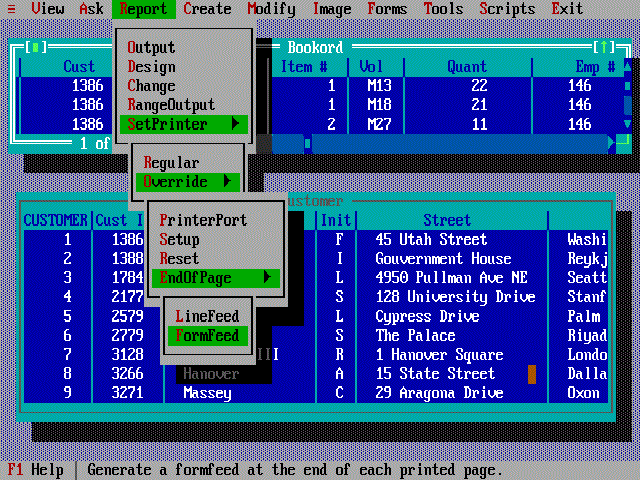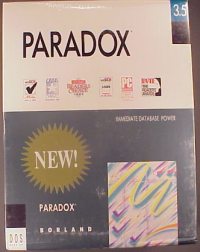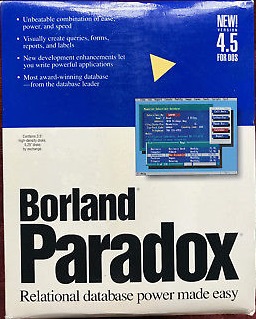Borland International, Inc.
Paradox
In 1985, a company called Ansa Software released a new high-speed relational database management system (RDBMS) for DOS 2.0 called Paradox. In September 1987, Borland purchased Ansa Software including their Paradox product.
Versions up to 3.5 were evolutions of Ansa Software's original version 1.0, but from 4.0 Borland retooled the product in Borland's C++ windowing toolkit and employed a different extended memory (XMS) access scheme. It was one of the most successful DOS-based databases, competing against dBase, Clarion, DataEase and R:Base.
One of the features that made Paradox unique and very accessible to non-technical buyers was its "Query By Example", or QBE. This meant rather than having to understand a query language to request data from the database, you were presented with a visual representation of tables where you could enter in commands and give examples and conditions. Microsoft later leveraged this functionality in its own product, Access.
Paradox 2.0 for DOS
Paradox 2.0 was released in 1986 (before Borland's buyout of Ansa Software), but for some version 2.0 boxes that were produced after, the cover read "Ansa - A Borland Company".
Paradox 3.0 for DOS
By the time Paradox 3.0 was launched, the product packaging mimicked the standard colourful, clean and professional image of the other products in the Borland suite. It sold for a list price of $725 or $995 for the LAN pack for five additional licences. The Run-time version was just $29.95. It didn't require a heavyweight PC either, being able to run on an IBM PC or XT machine with no hard disk. Of course a hard disk and faster processor were recommended, but not absolutely essential.
Paradox 3.0 featured an easy-to-use form designer for data entry purposes, including the ability to have multi-row fields on a form. Putting together queries that joined 3 or 4 multiple tables was extremely easy in Paradox - something that its competitors often had limitations on. It came with Personal Programmer, a means to develop applications using PAL (Paradox Active Language). This also had a built-in debugger. The included Data Entry Toolkit was a library of pre-written routines that could be employed by your application. The number of functions built-in was incredible, and on top of everything else, it was quick.
Compared to rival products at the time, Paradox 3.0 offered the best blend of ease-of-use, speed, and querying power.
Paradox 3.5 for DOS
Launched in August 1990, Paradox 3.5 was available on both 3.5" or 5.25" floppy disk and often both formats were shipped in the box. It came on nine 360 KB 5.25" floppies or five 720 KB 3.5" floppies.
Paradox SE for DOS
A "Special Edition" of Paradox arrived in October 1991. Designed to be a database "lite" for non-programmers. In fact Paradox SE was essentially the Paradox 3.0 product with some programming tools removed. It did, however, still include the powerful "Query by Example" (QBE) and full relational database capabilities, along with its report and form capabilities. Of course, lacking from Paradox SE were the enhancements found in Paradox 3.5, including improved memory management and the programmer support features like the Personal Programmer and DataEntry toolkit. Unlike other full-fat Borland products, SE did not ship with a suite of manuals - instead they provided a third-party book entitled The ABCs of Paradox along with an addendum brochure to cover the specifics of the SE version. It sold for just $99.95 retail, or $69.95 direct from Borland during its first month of release.
Paradox 4.0 for DOS
Paradox 4.0 had a list price of $795 at launch in August 1992, but you could upgrade an existing older version to 4.0 for just $199.95. It came on two 1.44 MB floppy disks, having been largely rewritten from scratch in Borland C++. Documentation was unchanged from version 4.0 to 4.5.
Paradox 4.5 for DOS
Launched in 1993, Paradox 4.5 was touted as being ten times faster than Paradox 3.5.
Paradox for Windows 1.0
In 1993, Borland released the first Windows version of Paradox. This had full compatibility with databases written in Paradox for DOS as well as dBase. At launch it sold for $495, but this was eventually reduced down to just $150.





A five-page spread for Borland Paradox for Windows [1.0], in March 1993
The next version for Windows realigned the version numbering to match the highest version for DOS, 4.5.
When Corel Corporation bought Borland, they continued the Paradox line of products, and included it in their Corel WordPerfect Office bundle.
Borland also ported Paradox to IBM OS/2, with version 1.0 for OS/2 released in summer 1988. A version 2.0 was also released for OS/2.



